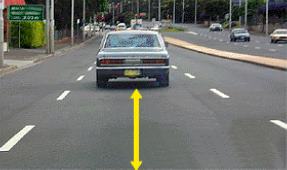This is a timed quiz. You will be given 45 seconds per question. Are you ready?
Taking regular breaks and swapping drivers is safest.
Build up your skills on familiar roads in daylight and light traffic. Progress to heavier traffic and unfamiliar roads once you are confident in your driving ability.
Turning up the radio and opening the windows have negligible effect on tiredness. Stopping and resting until you are not tired, or changing drivers is the best solution.
Taking a break will keep you more refreshed when driving.
You are responsible for your own driving.
Staying three seconds or more behind the vehicle in front will give you time to react in an emergency. If the conditions are wet, then you should increase this distance.
Checking over your shoulder allows you to see objects that might be in your blind spot.
You are the one responsible for your own driving, adhering to the road rules, and driving safely.
Your stopping distances will increase in the wet, and if visibility is impaired it may take you longer to react to an emergency situation so you should slow down. Other vehicles will not be able to see you as easily, therefore headlights are important.
Be especially careful when braking as oil and rain create a very slippery surface. Slow down to give yourself time to react, and also to allow for safe cornering and stopping.

Three seconds is a safe distance that gives you time to react and stop in an emergency situation.
Checking over your shoulder allows you to see objects that might be in your blind spot.
Driving long distances can be tiring and you increase your risk of falling asleep at the wheel.
High beam headlights will reduce your visibility and could dazzle other drivers. Following closer to other vehicles reduces your time to react to emergency situations.
Looking at the left of the road will allow you to judge where you are without being dazzled by the oncoming vehicle's lights. Your high beam lights could dazzle another driver, and you should not look directly at another vehicle's headlights as it will temporarily affect your vision.
Continually scanning in all directions keeps you aware of the situation all around you and gives you a better chance of reacting to emergency situations.
You are the responsible person for your driving and the safety of others as a result of your driving.
Slow down, look at the left hand edge of the road and wait until your eyes recover until you speed up again.
There is less friction on the road when it is wet, therefore you should allow for longer stopping distances.
Build up your skills on familiar roads when you start driving at night. Night driving is quite different to daytime driving, so removing that extra challenge of unfamiliar territory will help you improve safely.
It is more difficult to see the entire road situation at night, therefore leaving a longer gap gives you more time to react.
If you don't have anti-lock brakes heavy braking may lock the wheels, causing a skid. Once you are skidding you are out of control. If you do have anti-lock brakes, someone behind you could run into you
At night time it is more difficult to judge distances. Four seconds is a safe gap.
There is less friction on the road when it is wet, therefore you should allow for longer stopping distances.